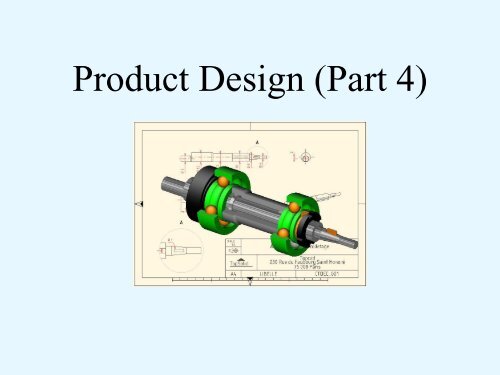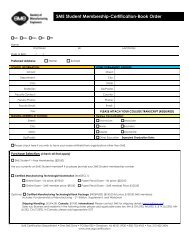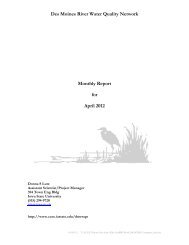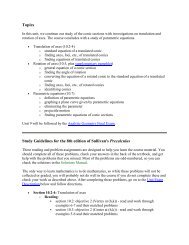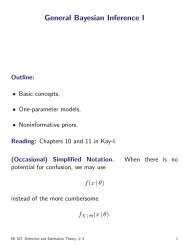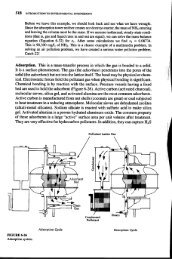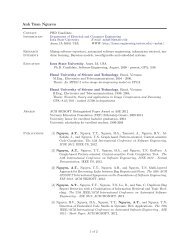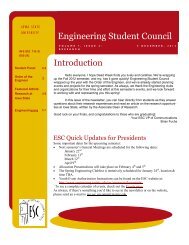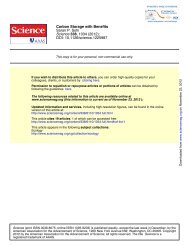CMfgT Study Guide Part 4 - Engineering Student Organizations
CMfgT Study Guide Part 4 - Engineering Student Organizations
CMfgT Study Guide Part 4 - Engineering Student Organizations
Create successful ePaper yourself
Turn your PDF publications into a flip-book with our unique Google optimized e-Paper software.
Product Design (<strong>Part</strong> 4)
<strong>Engineering</strong> DrawingChapter 16
Drawing Standards• Line conventions and lettering-ANSI/ASME Y14.2M-1992• Multiview and sectional view drawings-ANSI/ASME Y14.3M-1994• Pictorial drawing-ANSI/ASME Y14.4M-1989(1994)• Dimensioning and tolerancing-ANSI/ASME Y14.5M-1994
Line Types
F 16-1Line Types
<strong>Engineering</strong> Drawing
F 16-2 StandardsMultiview Projection
F 16-3 SymbolsProjection Symbols
Third Angle ProjectionF 16-4 Six principal views
Primary Auxiliary ViewF 16-5 Auxiliary view
Full Section
Half SectionThis side drawn in sectionImagine this place ofthe part removed.This side drawn as exterior view
Offset Section
Offset SectionCutting planeDo now show bendsin the cutting plane
F 16-8 Basic dimensionDimensioning
F 16-9 Reference dimensionDimensioning
F 16-10 Types of dimensioningDimensioning
F 16-11 Mating parts (inches)Tolerancing
F 16-12 Mating parts (inches)Tolerancing
F 16-13 Tolerances (inches)Tolerancing
System of Fits• Hole basis: The system of fits where theminimum hole size is the basic size.• Shaft basis: The system of fits where theminimum shaft size is the basic size
Fit Types• Clearance: Gap between mating parts• Interference: No clearance, force requiredfor assembly• Transition: Result in either a clearance or aninterference fit
Types of Fits• RC-running and sliding fits• LC-clearance locational fits• LT-transition locational fits• LN-interference locational fits• FN-force and shrink fits
Hole Basis Shaft Basis DescriptionH11/c11H9/d9H8/f7H7/g6H7/h6C11/hllD9/h9F8/h7G7/h6H7/h6Loose running fit for wide commercial tolerances orallowances on external members.Free running fit for running accurate machines andfor accurate location at moderate speeds and journalpressures.Close running fit for running on accurate machinesand for accurate location at moderate speeds andjournal pressures.Sliding fit not intended to run freely, but to move andturn freely and locate accurately.Locational clearance fit provides snug fit for locatingstationary parts: but can freely assembled anddisassembled.
Hole Basis Shaft Basis DescriptionH7/n6H7/p6H7/s6H7/u6N7/h6P7/h6P7/h6U7/h6Location transition fit for more accurate locationwhere greater interference is permissible.Locational interference fit for parts requiring rigidityand alignment with prime accuracy of location butwithout special bore pressure requirements.Medium drive fit for ordinary steel parts or shrink fitson light sections, the tightest fit usable with cast iron.Force fit suitable for parts which can be highlystressed or for shrink fits where the heavy pressingforces required are impractical.
Symbols and Their Definitions as Applied Holes and Shafts• Basic Size• HOLE• Fundamental Deviation• Basic Size• SHAFT• Fundamental Deviation• Basic Size• FIT• Hole Tolerance40 H840 F740 H8/f7• Tolerance Grade• IT Grade• Tolerance Grade• IT Grade• Fit• Shaft Tolerance
Tolerances for InterchangeabilityF 16-14 Car knob assembly
F 16-15 CriteriaSurface Texture
Surface SymbolsF 16-16 Standard lay Designations
F 16-17 ApplicationsSurface Symbols
Geometric Dimensioningand TolerancingChapter 17
F 17-1 ASME Y14.5M-1994
F 17-2 GD&T Tolerances and Symbols
F 17-3 Feature control frame
F 17-4 Flatness
F 17-5 Surface Straightness
F 17-6 Axis straightness
F 17-7 Axis straightness
F 17-8 Circularity
F 17-9 Cylindricity
F 17-10 Parallelism
F 17-11 Perpendicularity
F 17-12 Angularity
F 17-13 Circular runout
F 17-14 Total runout
F 17-15 Profile of a line
F 17-16 Profile of a surface
F 17-17 Concentricity
F 17-18 Symmetry
F 17-19 Tolerance of position
Computer-Aided DesignChapter 18
3D Modeling Methods• 1. Wire Frame• 2. Surface Modeling• 3. Solid Modeling
Wire FrameA. Advantages1. Easiest to construct2. Infinite number of views possibleB. Disadvantages1. Difficult to visualize complex objects2. Mass properties cannot be calculated
Surface ModelingA. Advantages1. Better representation of object compared towire frame2. Can be used to determine machine tool pathsB. Disadvantages1. Not a complete representation of real object2. Cannot be sectioned
Solid ModelingA. Advantages1. True 3D object2. Elimination of ambiguity in viewing model3. Section cuts can be produced and displayed4. Mass properties may be calculatedB. Disadvantages1. Software more expensive2. More memory is required
Modeling Uses
Circuit Board Layout• CAD software designed for printed circuitboards (PCB) has features unique to thatapplication.• Current surface mount technology (SMT)and the continued miniaturization ofintegrated-circuit products makes thedesign of most PCBs a complex task
PCB Design Considerations• The number of layers in a final boardassembly (single-sided, double sided, andmultilayered)• The miniaturization of components andthe effect on pin spacing and number ofpins in a conductor• Conductor routing and board layers
Design Considerations Contd.• The frequency of the current in thedifferent circuits and the resultinginductance• Heat dissipation• The placement of similar types ofcomponents
Rapid Prototyping Methods• Stereolithography apparatus (SLA)• Solid ground curing (SGC)• Laminated object manufacturing (LOM)• Fused deposition modeling (FDM)• Selective laser sintering (SLS)• Ballistic particle manufacturing (BPM)
Advantages of RapidPrototyping• Produce three dimensional parts within hours• Create masters and patterns• Accelerate prototype production• Achieve major savings in production of soft andhard tooling• Increase manufacturing capabilities with lowvolume production runs• Add impact to marketing concept presentationswith hands-on models• Improve the accuracy of vendor bid response
Disadvantages of RapidPrototyping• <strong>Part</strong>s typically cannot be used for physicaltesting• <strong>Part</strong>s have surface finish quality andtolerance limitations• Special techniques and materials arerequired of some systems• Equipment is expensive
Product Design ToolsChapter 19
Manufacturing Strategies•Customer Response•Entrepreneurial Manufacturing•Time Based Strategy•Managing For Speed Product
Customer Responsive•Targets quality improvement and customerservice•Uses short-run manufacturing via the workcell concept
Entrepreneurial Manufacturing•Requires flexible system capable ofshifting from one product to another onshort notice•Success is dependent upon a company’scapacity to create new markets forspecialized high-value-added products.
Time Based Strategy•Organization of process components andstandardization•Length of production run•Complexity of scheduling procedures•Favors smaller increments of improvement innew products, but introduces them more often
Managing for Speed ProductDepends on:•Organizing product development for speed•Organizing product manufacturing for speed•Using miscellaneous techniques for speed•Using computer-aided technology for speed
Manufacturing StrategiesCustomerResponsiveEntrepreneurialManufacturingAll strategies focus on delivering a quality product at acompetitive price simultaneously responding to customerneeds, and striving for continuous improvement.Time BasedStrategyManaging ForSpeed Product
Concurrent <strong>Engineering</strong> Principles• Understand your customer• Use product development teams• Integrate process design• Involve suppliers and subcontractors early• Use digital product models• Integrate CAE, CAD, and CAM tools• Use quality engineering and reliabilitytechniques• Create an efficient development approach• Improve the design process continuouslyT 19-1
F 19-1 Process failure mode and analysis
Quality Function Deployment(QFD)• A strategy/technique of listening to the“voice of the customer”
Benefits of Using a Quality FunctionDeployment Strategy• Earlier determination of key product characteristics• Documentation of actual customers’ needs rather thandecisions based on opinions• Reduction in product development costs• Reduction in time required to bring a new product tomarket• Greater customer satisfaction due to lower costs andimproved responsiveness• Reduction in number of engineering changes across theproduct’s life cycleT 19-6
Quality Function Deployment (QFD)F 19-2 Four stages of QFD
F 19-3 House of quality
F 19-4 QFD matrices
Group Technology (GT)• An approach to reduce manufacturingsystem information content by identifyingand exploiting the sameness or similarity ofparts based on their geometrical shapeand/or similarities in their productionprocess.
<strong>Part</strong> Families• Design-oriented: Have similar designfeature, such as geometric shape• Manufacturing-oriented: Can be based onany number of different considerations,such as parts manufactured by the sameplant or same materials
Methods of Grouping <strong>Part</strong>s• Visual inspection• Production flow analysis (PFA)• Classification and coding(Most effective and widely used)
Two Main Coding Systems1. Attribute-based (polycodes)2. Hierarchical-based (monocodes)
F 19-5 Attribute-based coding
F 19-6 Hierarchical-based coding


